🚗🏍️ Welcome to Motoshare!
Turning Idle Vehicles into Shared Rides & New Earnings.
Why let your bike or car sit idle when it can earn for you and move someone else forward?
From Idle to Income. From Parked to Purpose.
Earn by Sharing, Ride by Renting.
Where Owners Earn, Riders Move.
Owners Earn. Riders Move. Motoshare Connects.
With Motoshare, every parked vehicle finds a purpose. Partners earn. Renters ride. Everyone wins.
Travelers from all over the world are drawn to the Taj Mahal, a monument that represents unending love. This magnificent example of Mughal architectural skill is the ivory-white marble mausoleum in Agra, India, which is recognized as a UNESCO World Heritage Site. This comprehensive guide covers all the information you need to organize your visit, from ticketing and schedules to exploring the complex and taking in Agra’s rich tapestry.
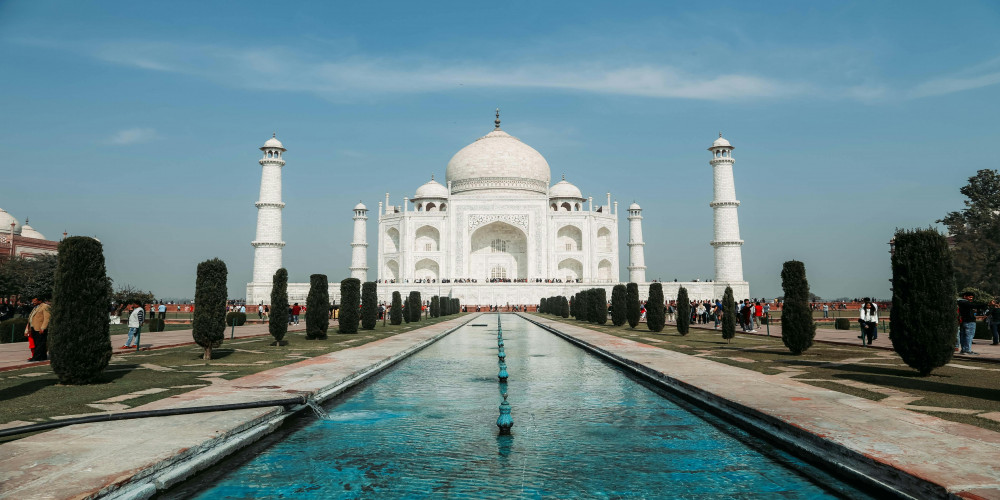
Introduction
- One of the most revered icons of love and architectural beauty in the world is the Taj Mahal, which is situated in Agra, India. The Mughal Emperor Shah Jahan commissioned this exquisite monument in 1631 in remembrance of his beloved wife Mumtaz Mahal, who passed away during childbirth. Built over a span of over two decades, this famous mausoleum blends aspects of Ottoman Turkish, Islamic, Persian, and Indian architectural styles to create a work of art that has enthralled people all over the world.
- The historical significance of the Taj Mahal goes beyond its use as a tomb. It symbolizes the pinnacle of Mughal construction and is frequently used to illustrate the artistic and cultural might of the empire. A stately gateway, a lovely garden, a mosque, a guest house, and several other opulent buildings are all part of the complex, which has been carefully designed.
- The Taj Mahal was acknowledged for its exceptional universal worth and the exquisite perfection of its artistry when it was named a UNESCO World Heritage Site in 1983. As “the jewel of Muslim art in India and one of the universally admired masterpieces of the world’s heritage,” according to UNESCO, it confirms its status as a lasting symbol of exquisite art and culture in addition to being a gigantic token of love. As a testament to the site’s significance as a treasure of human creation, this designation guarantees continued efforts to preserve it for future generations.
History and Architecture
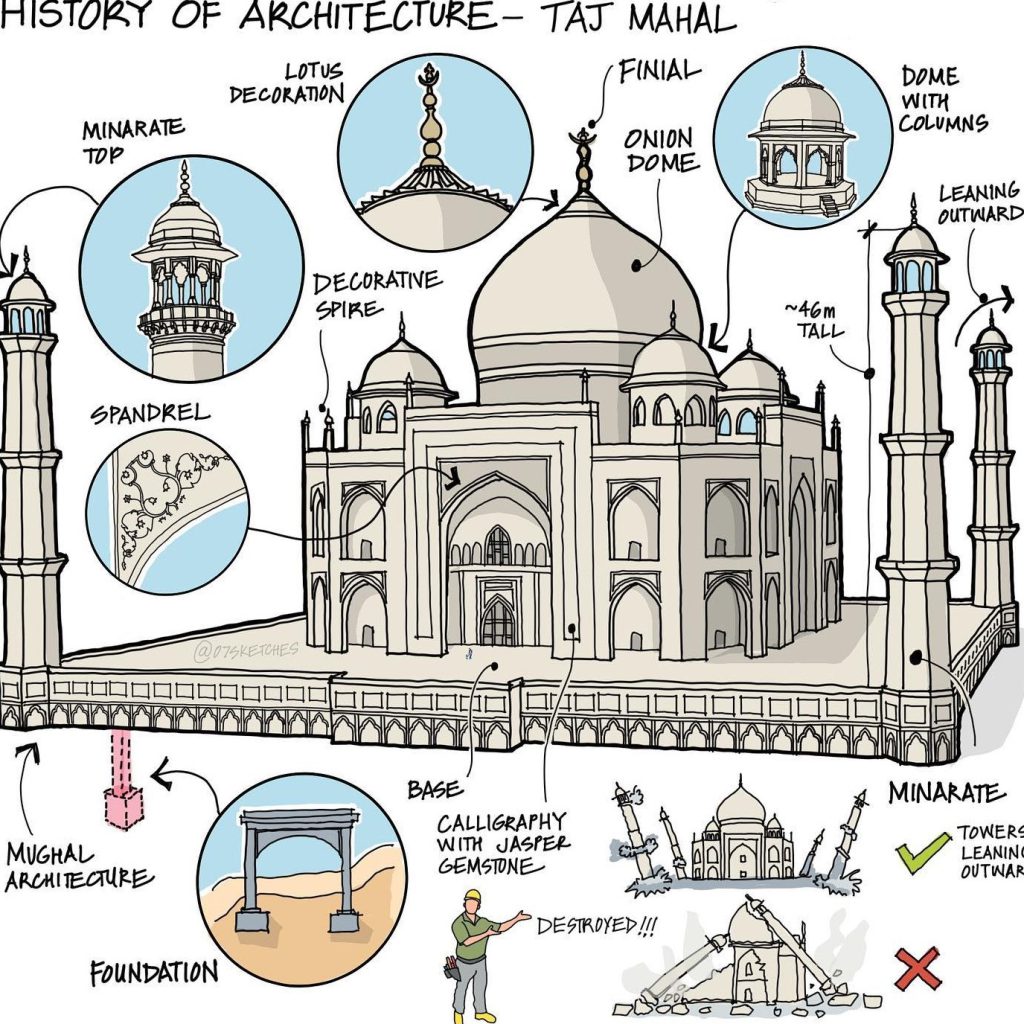
- Origins: The Taj Mahal was commissioned in 1632 by Emperor Shah Jahan in memory of his wife Mumtaz Mahal, who died giving birth to their 14th child. This mausoleum is a symbol of eternal love and is considered the pinnacle of Mughal architecture.
- Architectural Influence: The Taj Mahal blends elements from Persian, Islamic, and Indian architectural styles. The structure is renowned for its symmetrical precision, with the main mausoleum topped by a large, iconic dome, flanked by four smaller domed chambers.
- Construction Details: The complex was constructed using white marble from Rajasthan, jasper from Punjab, jade and crystal from China, turquoise from Tibet, Lapis lazuli from Afghanistan, sapphire from Sri Lanka, and carnelian from Arabia, among others. The precision of the inlay work, where semi-precious stones are embedded into the marble, showcases the extraordinary craftsmanship.
- Structural Innovations: The minarets that surround the tomb were designed with a slight outward lean, to protect the main mausoleum in case they ever fell.
Hidden Gems
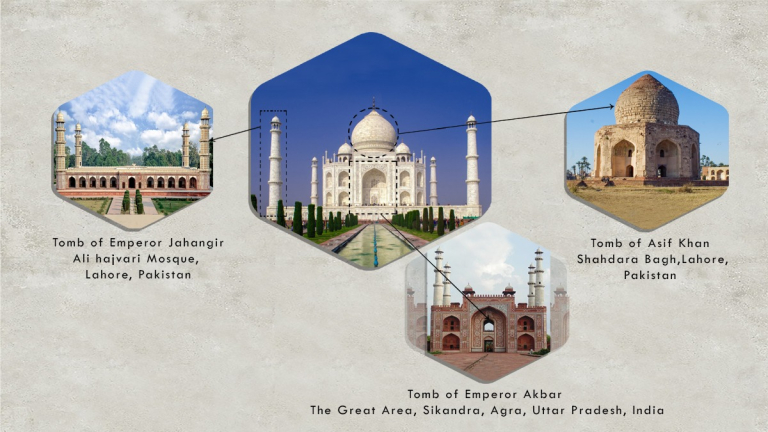
- The Basement: Beneath the main level lies the actual tomb of Mumtaz Mahal and Shah Jahan, which is not usually accessible to the public but can be viewed from above at certain times.
- The Calligraphy: Look closely at the Arabic calligraphy around the main archway of the mausoleum. The letters increase in size as they move upward, making them appear uniform from the ground, a testament to the meticulous attention to perspective.
- Acoustic Echoes: The main dome of the Taj Mahal has a remarkable acoustic feature. Any sound made inside the dome echoes several times. Visitors often clap their hands to experience this phenomenon.
- Moonlight Garden (Mehtab Bagh): Directly across the Yamuna River, this now beautifully restored garden offers a splendid view of the Taj Mahal, particularly under moonlight. It’s believed to have been part of the original design by Shah Jahan.
Exploring the Taj Mahal
Main Mausoleum
- Overview: The centerpiece of the complex, renowned for its stunning white marble and intricate inlay work of precious and semi-precious stones.
- Highlights: The detailed calligraphy around the archways, the lattice screens, and the false sarcophagi of Mumtaz Mahal and Shah Jahan in the main chamber.
The Gardens
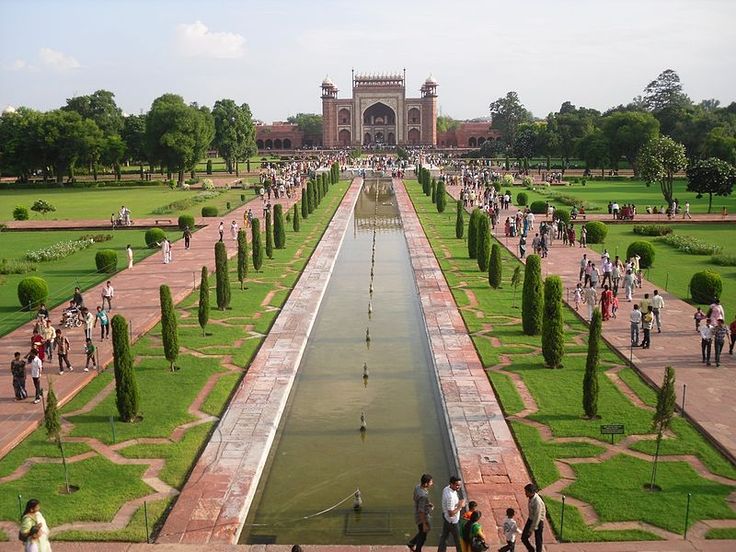
- Design: The Taj Mahal is set within a large Charbagh, a Persian-style garden divided into four parts by watercourses, symbolizing the rivers of Paradise.
- Experience: Enjoy a serene walk through these well-maintained gardens, offering great views and photo opportunities of the mausoleum against lush greenery and reflective water channels.
The Great Gate (Darwaza-i Rauza)
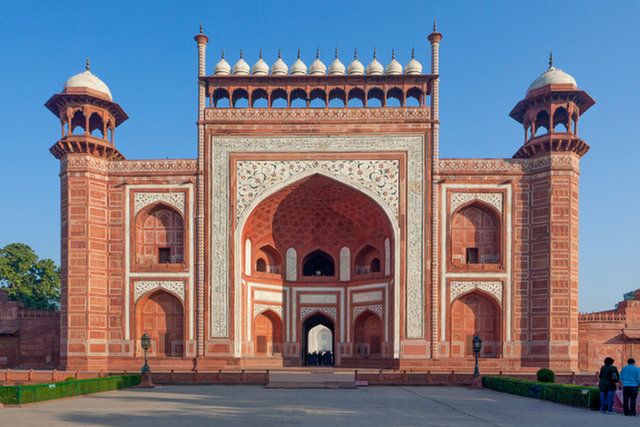
- Significance: This is the main gateway to the gardens and the tomb, inscribed with Quranic calligraphy, serving as a grand introduction to the Taj Mahal.
- Architecture: Notice the red sandstone contrasted with white marble and the intricate work on its domes.
The Mosque and the Guest House
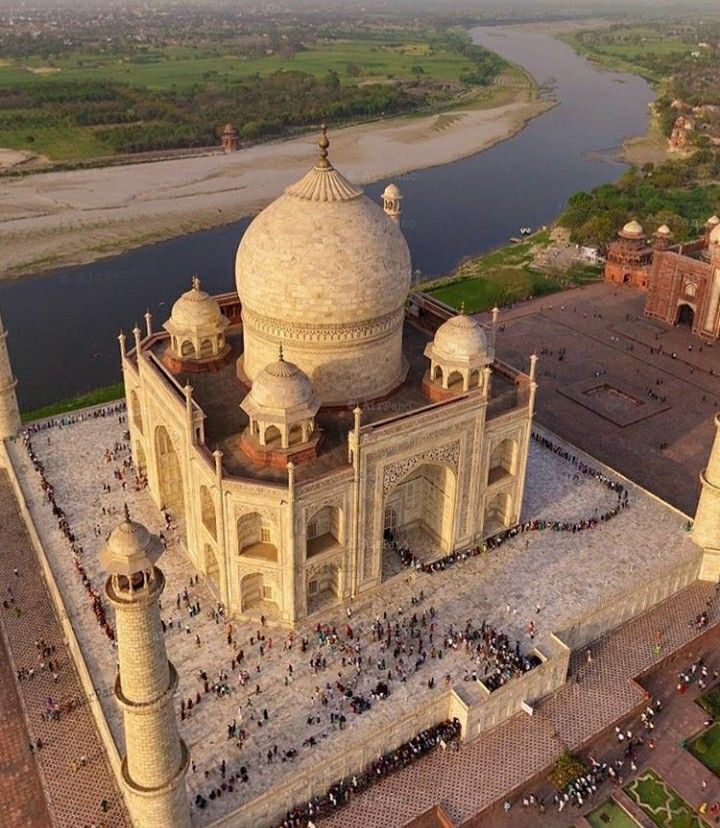
- Architecture: Flanking the main mausoleum are two symmetrically identical buildings made of red sandstone: a mosque to the west and a guest house to the east.
- Purpose: The mosque is still used for prayers, adding a religious element to the site, while the guest house (Mihman Khana) served to balance the symmetry and may have been used for royal gatherings.
The Museum
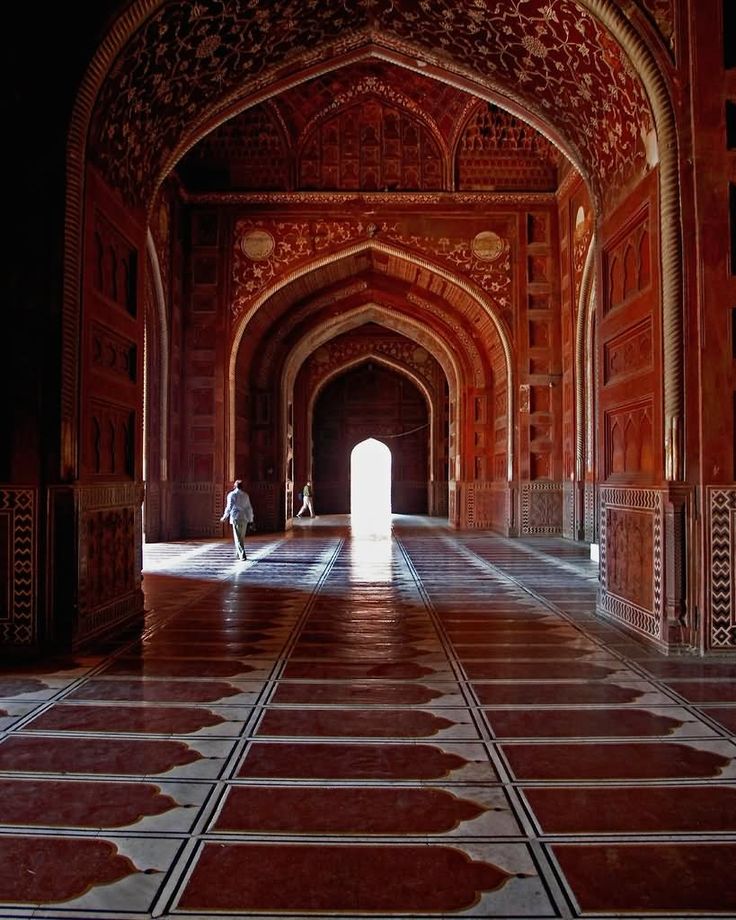
- Located: In the Jal Mahal, to the west of the main mausoleum.
- Exhibits: The museum houses original architectural drawings of the Taj Mahal, along with artifacts from the Mughal era, including ceramics and antique coins.
Photographic Points
- Diana’s Bench: Famous photo spot where Princess Diana was photographed, offering one of the best views of the Taj.
- North and South Pools: For reflective photographs of the Taj Mahal, visit the pools in the gardens, especially stunning during sunrise and sunset.
Planning Your Visit to the Taj Mahal
Best Times of the Year to Visit
The Taj Mahal is situated in Agra, a region with a marked climate of hot summers, pleasant winters, and a monsoon season. Here are the best times to visit based on weather and tourist seasons:
- Winter (October to March): This is the ideal time to visit the Taj Mahal. The weather remains cool and pleasant, which makes it comfortable for exploring the monument and its surroundings. The mornings can be a bit foggy, especially in December and January, which adds a mystical appeal to the monument, although it might obscure the view until the fog lifts.
- Spring (Late February to March): The weather starts warming up but remains comfortable. The crowd starts to thin out as peak tourist season winds down, providing a more relaxed experience.
- Monsoon (July to September): Though not the peak season due to high humidity and occasional rain, the monsoon brings lush greenery to the gardens of the Taj Mahal, making them beautifully vibrant. This can be a good time to visit if you prefer fewer tourists and don’t mind carrying an umbrella.
Avoid visiting during the summer months (April to June), as temperatures can soar up to 40 degrees Celsius (104 degrees Fahrenheit), making it extremely challenging to enjoy your visit.
Suggested Durations for Visits
To fully appreciate the Taj Mahal, consider the following durations for your visit:
- Short Visit (2-3 hours): This is sufficient to explore the main mausoleum, take some photos, and walk through the gardens. This duration is typical for tourists who are on a tight schedule or part of larger guided tours that cover multiple attractions in a single day.
- Half-Day Visit (4-5 hours): A half-day visit allows you to explore at a more leisurely pace, including the mosque, the guest house, and the outer courtyards. You’ll have more time to appreciate the intricate details of the marble inlays, and enjoy the peaceful ambiance early in the morning or late in the afternoon.
- Full-Day Visit: Spending a full day at the Taj Mahal is recommended for photography enthusiasts and those deeply interested in architecture and history. This duration lets you witness the changing colors of the marble as the sun transitions from sunrise to sunset, which is a breathtaking sight.
Visiting during sunrise is particularly recommended as the early morning light illuminates the white marble, changing its color from soft grey and yellow to pearly cream and dazzling white. This is also the best time for photography, with fewer crowds and cooler temperatures.
Getting There:
Agra, home to the iconic Taj Mahal, is well-connected to major cities across India by air, train, and road. Here’s how you can reach Agra from various metropolitan areas:
| Mode of Travel | Details |
|---|---|
| By Air | Airport: Agra’s Kheria Airport (limited flights), nearest major airport is Indira Gandhi International in New Delhi. |
| Distance from Delhi: Approx. 220 km | |
| Travel Time: 3 to 4 hours by road or train from Delhi | |
| By Train | Major Stations: Agra Cantt, Agra Fort, Raja ki Mandi, Agra City |
| From Delhi: Gatimaan Express (~100 minutes), Shatabdi Express (~2 hours) | |
| From Mumbai: Rajdhani Express and others (12 to 15 hours) | |
| From Kolkata: Udyan Abha Toofan Express, Kolkata Rajdhani (17 to 20 hours) | |
| From Jaipur: JP AF Shatabdi (~4 hours) | |
| By Road | From Delhi: Via Yamuna Expressway (3 to 4 hours) |
| From Jaipur: Via NH 21, about 240 km (4 to 5 hours) | |
| From Lucknow: Via Agra-Lucknow Expressway, about 330 km (~4 hours) | |
| By Bus | Connections: Excellent connections from Delhi, Jaipur, Lucknow, etc. |
| Types of Buses: State-run and private luxury coaches available |
Visas and Entry Requirements:
| Requirement | Details |
|---|---|
| Visa Types | Most tourists will require an e-Tourist Visa or a regular Tourist Visa depending on their travel plans. |
| Application | Applications for e-Visas can be completed online. Regular visas require application at Indian embassies or consulates. |
| Validity | e-Tourist Visas are generally valid for 30 days from the date of arrival, extendable for longer stays depending on the visa type. |
| Documents | Passport valid for at least six months, recent photograph, and other personal and travel details. |
| Cost | Fees vary by nationality and type of visa. Detailed fee structures are available on the official visa website. |
| Processing Time | e-Visa processing is typically within 72 hours. Regular visas may take longer depending on the embassy. |
| Entry Points | e-Visas are valid for entry at designated airports and seaports. Regular visas allow broader entry options. |
| Additional Information | Some nationalities may be eligible for visa on arrival. Check specific eligibility on the official site. |
Local Transportation:
| Taxis | Available throughout the city; can be hired for the day or for specific trips. Metered and fixed fare options are common. |
| Auto Rickshaws | An economical and flexible option; ideal for short distances. Bargaining on fare is typical. |
| Cycle Rickshaws | Suitable for shorter, scenic rides especially around busy tourist areas; fares should be negotiated before the ride. |
| Ride-Sharing Services | Services like Ola and Uber are available and can be a convenient way to travel around the city. |
| Battery-Operated Buses | Operate in the area around the Taj Mahal, providing a pollution-free way to visit nearby attractions. |
| Local Buses | Run by state transport services, these cover longer routes across the city at very low costs, but may be crowded. |
Ticketing and Entry:
- Ticket Types:
- Regular Entry: Allows access to the main complex, gardens, and mausoleum (₹50 for Indians, ₹1100 for Foreign Tourists & NRIs, ₹540 for SAARC & BIMSTEC Countries).
- Express Entry: Offers shorter queues for entry (prices slightly higher than regular entry, purchased online or at designated counters).
- Full Moon Night Viewing: Allows entry on nights with a full moon and two days before and after (₹500 for all nationalities, book one day in advance).
- Timing:
- Regular Visit: Open daily from sunrise to sunset (approximately 6:00 AM to 6:30 PM) except Fridays (open for prayers in the afternoon).
- Night Viewing: On full moon nights and two days before and after, open from 8:30 PM to 12:30 AM.
- Booking: Tickets can be purchased online through the Archaeological Survey of India (ASI) website ([ASI Taj Mahal Tickets]) or at the ticket counters at the Western and Eastern gates (open one hour before sunrise to 45 minutes before sunset). There’s a slight discount for online booking (₹5 for Indians and ₹50 for foreigners).
- Travel Planning and Advice:
- Holidaylandmark – Provides tips on travel in Agra.
- Entry Guidelines: Dress modestly (avoid shorts, sleeveless shirts), avoid bringing large bags, knives, or tripods.
Visitor Tips
- Guided Tours: Consider hiring an official guide or joining a group tour for detailed historical insights and hidden stories about the Taj Mahal.
- Night Viewing: On select days around the full moon, night viewings are available, showcasing the Taj Mahal in a different light.
Where to Stay
Here’s a tabular summary of accommodation options in Agra for a range of budgets, along with current prices and links for more information:
| Hotel Name | Price Range (Per Night) | Description | Website for More Information |
|---|---|---|---|
| The Oberoi Amarvilas Agra | Starting at $639 | Luxury hotel with views of the Taj Mahal, exceptional service and amenities. | The Oberoi Amarvilas |
| ITC Mughal, A Luxury Collection Resort & Spa, Agra | About $78 | Offers spa services, pool, and grandeur reflecting the Mughal era. | ITC Mughal |
| Taj Hotel & Convention Centre, Agra | Around $72 | Features modern amenities including a pool and spa, suitable for business and leisure. | Taj Hotel & Convention Centre |
| Courtyard by Marriott Agra | Approximately $60 | Well-rated for its service and modern facilities, including a pool and spa. | Courtyard by Marriott |
| Radisson Hotel Agra | About $53 | Budget-friendly option with comfortable accommodations, pool, and spa. | Radisson Hotel Agra |
Remember: Prices mentioned are a rough estimate and can vary depending on the season and room type. Research and book your accommodation well in advance, especially during peak tourist season.
What to Expect
Architectural Features of the Taj Mahal
Main Mausoleum:
- Structure: The Taj Mahal is renowned for its symmetrical beauty. The main mausoleum is constructed of white marble and features a large dome topped with a finial. The dome is approximately 35 meters high and is surrounded by four smaller domes.
Decoration: The exterior decorations of the Taj Mahal are among the finest in Mughal architecture. Calligraphy of Persian poems and intricate floral motifs inlaid with semi-precious stones adorn the surfaces.
Interior: Inside, the mausoleum holds the cenotaphs of Mumtaz Mahal and Shah Jahan. The actual graves are at a lower level.
Surrounding Gardens:
- Layout: The Taj Mahal is set within a formal garden (charbagh), which is divided into four equal parts. These parts are further subdivided into smaller sections by walkways or flowing water.
Symbolism: The garden symbolizes the four flowing rivers of Jannah (Paradise) and reflects the paradise garden described in the Quran.
Outlying Buildings:
- Mosque and Guest House: To the west of the main mausoleum is a mosque made of red sandstone; it complements the symmetry of the Taj Mahal. To the east is the Jawab, a building identical in design to the mosque but originally used as a guest house.
Main Gateway: The main entrance to the Taj Mahal is a grand gateway made of red sandstone and adorned with verses from the Quran, setting the spiritual tone for visitors.
Art and Craftsmanship
- Pietra Dura: The Taj Mahal is famous for its pietra dura decorations, a type of inlay work using highly polished colored stones to create images. The walls are decorated with exquisite designs of flowers and vines made from thousands of semi-precious stones.
Calligraphy: The calligraphy on the Taj Mahal mainly consists of verses from the Quran and reflects traditional elements of Islamic art. The higher the panels, the larger the script, creating a uniform appearance from the ground. - Marble Carving: The marble carvings in the Taj Mahal are of high precision and delicacy, showcasing the high level of craftsmanship achieved by the artisans of the time.
This architectural marvel is not only a symbol of Shah Jahan’s love for his wife, Mumtaz Mahal, but also a testament to the rich artistic and architectural heritage of the Mughal era.
Tours and Guides
How to book guided tours and the benefits of having a knowledgeable guide.
- Online Platforms: Many travel websites and platforms offer pre-booked guided tours to the Taj Mahal. You can select a tour based on ratings, languages offered, and price.
- Local Travel Agents: Local agents in Agra or nearby cities like Delhi and Jaipur can arrange guided tours, often as part of a larger travel package.
- On-Site: You can often find authorized guides available for hire directly at the entrance of the Taj Mahal. These guides are usually licensed by the government and carry ID badges.
Benefits of Having a Knowledgeable Guide
- Insightful Narration: A knowledgeable guide can provide detailed commentary on the history, architecture, and legends associated with the Taj Mahal, enriching your visit.
- Cultural Context: Guides help visitors understand the cultural significance and the architectural genius behind the monument.
- Navigation: They can efficiently navigate through the complex, helping you to avoid crowded spots and making the visit more enjoyable.
- Language Support: For non-Hindi speakers, guides available in multiple languages can make the visit more informative and engaging.
Best Times and Locations for Photography at the Taj Mahal
Best Times:
- Early Morning: Capture the Taj Mahal at sunrise when the changing light bathes the marble in soft, golden hues. The early hours also mean fewer tourists, allowing for clearer shots.
- Late Afternoon: The late afternoon light provides a warm glow and the setting sun can create spectacular backdrops.
- Full Moon Nights: For a unique experience, photographing the Taj Mahal on a full moon night is exceptional. The marble reflects the moonlight, creating a surreal effect.
Best Locations:
- Main Gate (Darwaza-i Rauza): The view from the main entrance offers a classic framed shot of the Taj Mahal.
- Garden Area: The gardens along the central walkway leading up to the mausoleum provide several angles for capturing the reflection in the water channels.
- Red Sandstone Mosque: To the west of the main structure, this location offers a beautiful perspective of the Taj against the sky.
- Yamuna River Bank: For a less common view, the banks of the Yamuna River behind the Taj Mahal offer a unique backdrop and a tranquil setting.
Photography Rules at the Taj Mahal
Tripod Use:
- Restrictions: Tripod use is generally prohibited inside the Taj Mahal complex to avoid disruption to visitors and preserve the site’s integrity.
- Professional Photography: For commercial or professional photography requiring equipment like tripods, prior permission must be obtained from the Archaeological Survey of India (ASI).
Restricted Areas:
- Interior of the Main Mausoleum: Photography is not allowed inside the main mausoleum, particularly near the cenotaphs. This restriction helps maintain the sanctity of the burial site.
- Certain Architectural Elements: Some specific architectural features may have restrictions on photography to prevent damage and preserve their historical significance.
To ensure a smooth visit, always check the latest guidelines from the ASI and respect signage about photography restrictions while at the Taj Mahal.
Amenities at the Taj Mahal
Facilities Available On-Site:
- Restrooms: There are adequate restroom facilities available at multiple locations around the Taj Mahal complex. These are maintained by the Archaeological Survey of India.
- Water Stations: Drinking water stations are available, but it’s advisable for visitors to carry their own water bottles, especially during the hot months.
- First Aid: First aid services are accessible within the complex. Staff are trained to assist with basic medical needs, and there are designated first aid rooms.
Accessibility Features for Disabled Visitors
- Wheelchair Accessibility: The Taj Mahal is accessible to wheelchair users. Wheelchairs are available free of charge at the entrance on a first-come, first-serve basis.
- Ramps and Paths: Ramps and smooth pathways are provided for easy movement throughout the complex, including to the main mausoleum.
- Special Entry: There is a separate entry gate for disabled visitors to avoid the queues, ensuring a more comfortable access.
- Assistance: Staff are generally available to assist disabled visitors. It’s advisable to request any specific assistance ahead of your visit to ensure availability.
The Taj Mahal’s administration strives to accommodate all visitors, including those with disabilities, to ensure a comfortable and enriching experience.
Recommendations for Local Eateries Near the Taj Mahal

When visiting the Taj Mahal, there are several local eateries nearby that offer a taste of authentic Indian cuisine:
- Pinch of Spice: A favorite among locals and tourists alike, this restaurant serves a variety of North Indian dishes. Don’t miss their butter chicken and paneer tikka.
- Shankara Vegis Restaurant: Ideal for vegetarians looking for a range of tasty options, including thalis and fresh juices.
- Peshawri: If you’re in the mood for more upscale dining, Peshawari offers delicious tandoori dishes in a sophisticated setting.
- Joney’s Place: Known for its casual vibe, Joney’s serves delicious masala chai and local snacks like aloo tikki.
Local Foods to Try:
- etha: Agra’s famous sweet, made from ash gourd and available in various flavors.
- Kebabs: Sample some of the local kebabs, which are a culinary staple in this region.
- Dalmoth: A spicy, savory snack made of lentils, nuts, and spices—perfect for munching on the go..
Tips on Staying Hydrated in Agra’s Climate
Agra can be hot and dry, especially from March to June. Here are some tips to stay hydrated and healthy:
- Carry Water: Always have a bottle of water with you. Bottled water is readily available and relatively inexpensive.
- Avoid Tap Water: Stick to bottled or filtered water to avoid stomach ailments.
- Use Rehydration Salts: If you’re out in the heat for extended periods, consider using rehydration solutions or electrolyte powders.
- Eat Fresh Fruits: Incorporate fresh fruits into your diet, as they can provide natural hydration and are readily available in local markets.
- Dress Appropriately: Wear light, breathable clothing and a hat to protect against the sun, further helping to prevent dehydration.
These tips should help you enjoy your visit to the Taj Mahal comfortably, even in the heat.
Cultural Etiquette at the Taj Mahal
Visiting the Taj Mahal is not only a journey to a historic site but also an encounter with a place of deep cultural and emotional significance. Observing respectful behavior and adhering to certain decorum is crucial for all visitors.
Respectful Behavior:
- Quiet and Calm: Maintain a quiet demeanor as you explore. Loud conversations or laughter might disturb other visitors who come to appreciate the serene environment.
- Photography: Always be mindful when taking photos. Avoid posing in ways that could be considered disrespectful near the tombs inside the mausoleum.
- Littering: It is essential to keep the surroundings clean; hence, do not litter. Use the bins provided throughout the complex to dispose of any waste.
Dress Code and Decorum:
- Modest Dress: It is advisable to dress modestly when visiting the Taj Mahal. Shoulders and knees should be covered; wearing long trousers and long-sleeved shirts is a good option.
- Shoes Off: Visitors must remove their shoes before entering the main mausoleum, or you can opt to wear shoe covers available at the entrance.
- Avoid Public Displays of Affection: As a sign of respect towards the cultural norms, visitors should avoid public displays of affection such as hugging or kissing within the complex.
Shopping and Souvenirs

Local Crafts:
Agra is renowned for its intricate marble inlay work, similar to the craftsmanship seen in the Taj Mahal itself. These include beautifully crafted marble tabletops, coasters, and ornate boxes. Leather goods are another local specialty, with Agra being one of the major manufacturing hubs for high-quality leather in India. Additionally, you can find handwoven carpets and brassware.
Where to Buy Souvenirs:
- Sadhu Bazaar for marble and stone handicrafts.
- Kinari Bazaar offers a range of products including jewelry, fabrics, and garments.
- Subhash Bazaar is known for its silk products and saris.
Tips on Bargaining:
Bargaining is common in the markets of Agra. It is usually acceptable to start negotiating at about half the initial price offered and work your way up to a mutually agreeable price.
Safety and Health
Safety Tips:
- Always be aware of your surroundings and keep your belongings secure.
- Be cautious of scams, especially from individuals offering unsolicited help or guiding services.
- Drink bottled water to avoid waterborne illnesses.
Health Care:
Agra has several hospitals and clinics that cater to both minor and major medical concerns. Some reputable facilities include the Agra City Hospital and Pushpanjali Hospital & Research Centre. Pharmacies are readily available throughout the city, with some open 24/7.
- Nearby Hospitals:
- Apollo Pankaj Hospitals – A well-equipped multi-specialty hospital in Agra.
- Pushpanjali Hospital & Research Centre – Offers 24/7 emergency services and is located near the Taj Mahal.
- Toll-Free Numbers:
- Tourist Helpline (India): 1363 or +91-1800-11-1363 – Available 24/7, offering assistance in several languages.
- Medical Emergency: 108 – This is the toll-free number for emergency services in India, including ambulance services.
- Police: 100 – Nationwide toll-free number for the police.
Frequently Asked Questions About Visiting the Taj Mahal
- What are the opening hours of the Taj Mahal?
The Taj Mahal is open from sunrise to sunset every day except Fridays, when it is closed for general viewing but open for afternoon prayers for local residents.
- Are there any tickets required to enter the Taj Mahal?
Yes, visitors need to purchase tickets. Tickets can be bought online or at the ticket counters near the entrance gates. There are different ticket prices for Indian citizens, SAARC and BIMSTEC country nationals, and foreign tourists.
- Can I visit the Taj Mahal on a Friday?
The Taj Mahal is closed to tourists on Fridays for maintenance and prayers. It is only open to worshippers attending the mosque within the complex.
- What should I bring for my visit to the Taj Mahal?
Visitors should bring a valid ID, wear comfortable walking shoes, carry water (especially during hot months), use sunscreen, and have a hat or umbrella for shade.
- Is photography allowed inside the Taj Mahal?
Photography is allowed in the premises but not inside the main mausoleum. Use of tripods or any other extensive photographic equipment is prohibited unless with special permission.
- Are there any restrictions on what I can bring into the Taj Mahal?
Yes, items such as food, tobacco products, knives, and large bags are not allowed inside. There are facilities near the gates where visitors can store their belongings.
- How much time should I allocate for a visit to the Taj Mahal?
Most visitors spend around 2 to 3 hours at the Taj Mahal. However, if you are keen on photography or wish to take a guided tour, you might want to allocate more time.
- Is the Taj Mahal accessible for visitors with disabilities?
Yes, the Taj Mahal is accessible for visitors with disabilities. Wheelchairs are available free of charge at the entrances, and there are accessible pathways throughout the complex.
- Are there facilities for food and drinks inside the Taj Mahal complex?
No, selling or consuming food inside the complex is prohibited. However, there are several eateries located near the complex where visitors can dine before or after their visit.
- What is the best time of year to visit the Taj Mahal?
- The best time to visit is between October and March when the weather is cooler. Early morning visits are recommended to avoid the crowds and the heat.
These FAQs cover the basic information needed when planning a visit to the Taj Mahal, ensuring a smooth and enjoyable experience.
Conclusion: Visiting the Taj Mahal
Visiting the Taj Mahal is an unforgettable journey into the heart of India’s rich history and cultural heritage. This magnificent monument, recognized as a UNESCO World Heritage Site, stands as a testament to the timeless love story between Shah Jahan and Mumtaz Mahal and the architectural ingenuity of the Mughal era.
When planning your visit, it’s important to appreciate the Taj Mahal not just as a stunning visual spectacle, but also as a sacred site that commands respect and reverence. Observing the local customs and regulations, dressing modestly, and maintaining decorum are all part of showing respect for the site’s cultural and historical significance.
Whether you’re capturing the ethereal beauty of the marble facade at sunrise, exploring the intricately landscaped gardens, or marveling at the detailed artistry of the interiors, the Taj Mahal offers a profound glimpse into the artistic and architectural achievements of its time.
As you walk through the gates of this iconic monument, take a moment to appreciate the effort and skill that went into its creation. Remember to tread lightly, respect the surroundings, and leave no trace behind, ensuring that the majesty of the Taj Mahal can be preserved for future generations to experience and cherish.
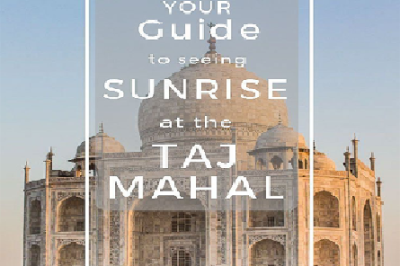
Taj Mahal is a true symbol of love. Beautifully captured in this blog.
A perfect guide for first-time visitors! Taj Mahal looks even more special through your words.
It’s clear you really understand what travelers need. This is awesome!
Taj Mahal Tour Package
“Taj Mahal ek amar prem ki nishani hai jo hamesha yaad rahegi.”
✨ “Discover the serenity of the Taj Mahal in the early hours with our Sunrise Taj Mahal Tour, as the white marble shimmers under the rising sun.”
“Truly a masterpiece of Mughal architecture – a must-see!”
URL-https://www.tajmahaltourpackage.in/
URL-https://noida-airport.com/
“Visitors admire the detailed carvings of the Taj Mahal walls.”
“The Taj Mahal is a magnificent blend of love, beauty, and architectural mastery. Its glowing white marble, intricate designs, and serene surroundings create a peaceful, enchanting atmosphere. Standing before this iconic wonder fills the heart with awe and wonder. Every detail showcases extraordinary craftsmanship, making a visit to the Taj Mahal an unforgettable and emotionally uplifting experience.”
URL-https://tajwithguide.com/
“The Taj Mahal is a timeless wonder that captivates with its beauty and grace. Its pristine white marble, delicate carvings, and symmetrical architecture create an enchanting sight. The peaceful gardens and reflective pools add to its serene atmosphere. Every moment spent here feels magical, making the Taj Mahal an unforgettable monument that leaves every visitor awestruck and inspired.”
URL-https://tajwithguide.com/